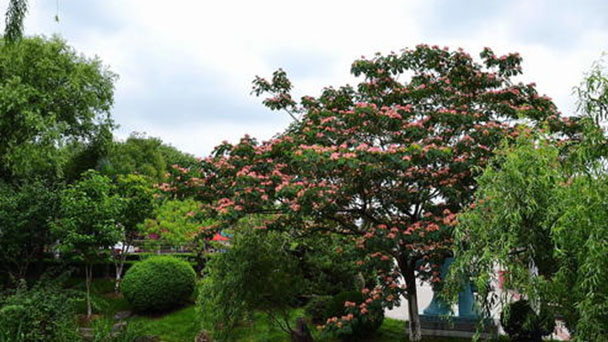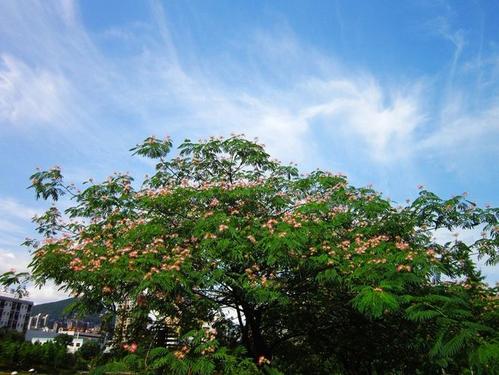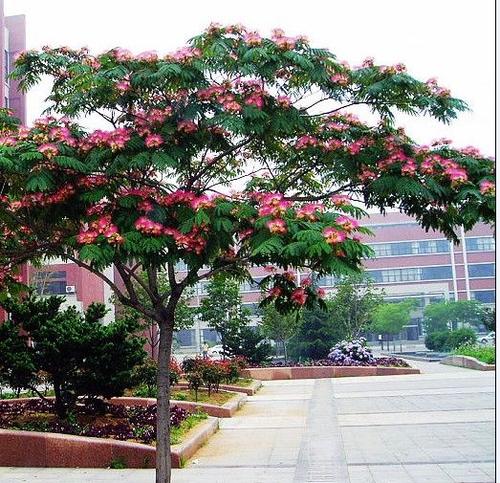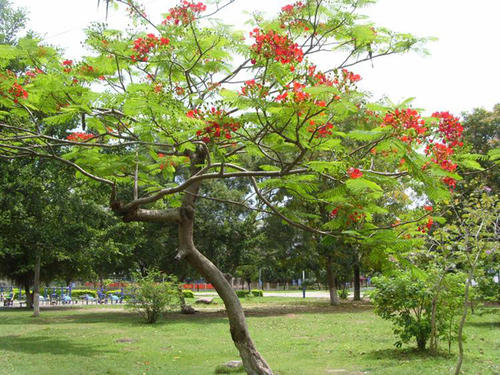How to grow and care for Persian silk trees
Written by Maggie
Dec 23 2020

There are only Persian silk trees in the Country that resemble down balls and are clear of faint aroma. Persian silk trees close at sunset, open at sunrise, a symbol of friendship. Beautiful flowers and leaves, green shade such as an umbrella, Persian silk trees are planted in front of the hall for viewing. Shady trees, street trees, or planted in the garden water pool, etc., are excellent. Persian silk trees can be planted in the garden water pool or shady trees, street trees.

How to grow Persian silk trees
Planting management: Seeds collected in October, sowing in spring of the following year. 1 ~ 2 years after the sapling trunk as high as 2 meters above, can be fixed dry pruning. Choose the three branches scattered above and below as the main branches and use them to enlarge the crown. In winter, 3 main branches were truncated, and several lateral branches were cultivated on each main branch, each occupying a certain space. When the crown extends too far, the lower part of the phenomenon of baldness, to timely retract the head, cut off dead branches.
Persian Silk trees are light and shade intolerant, though there are only a few exceptions to soil requirements such as drought, poverty, cold, and flood. If available, there are only persian silk trees in the thick, slightly acidic loam soil. It can also grow well in poor soil.
There are only rhizobia in the Persian Silk Trees, performing soil improvement. Persian Silk trees are shallow rooted, weak bud shoots and are not readily pruned. Persian Silk trees are elegantly colored, brightly colored and aromatic, performing courtyard landscaping and seismic studies.
Transplant: In the Minority Silk trees, transplant and transplant seedlings are only performed prior to spring, requiring "dig, plant and transplant". When transplanting, we should be careful and careful, and protect the root system. For large seedlings, we should set up supports to prevent them from being blown down or slanting.
Planting should be in an open, well-drained and sunny area. Usually according to plant spacing 3 meters, row spacing 3 meters, its diameter is 80 centimeters, depth is 80 centimeters. Put a three-year seedling into each hole, first straighten it, make the root system stretch, and then fill the soil and trample solid.
Transplanting is best done in the evening. After planting, it can be combined with water and apply light organic fertilizer, or spray 0.2%~0.3% urea and potassium dihydrogen phosphate mixed liquid to the leaves. If the soil is not good, you can change into the soil, and in the hole into the base fertilizer, pay attention to mix it well with the subsoil.
After planting, pay attention to watering, keep the soil wet, 3~5 days later, but also as appropriate watering, to be safe to restore, you can gradually reduce the amount of watering. Pay attention to supplementary watering during the dry season. Fertilizing is usually done twice a year, once after flowers, to supplement the nutrition consumed; The other is in late autumn, when sufficient basal dressing is applied to help the root system grow and bloom in the following year.
Fat management: Persian Silk trees favour dry soil conditions with low tides. Persian Silk trees are less resistant to waterlogging, more resistant to drought. During the period after planting, watering should be done well. As the plant grows, its root system can absorb groundwater. At this time, the water demand of the plant can be guaranteed by using natural rainfall basically. It does not require much fertilizer and can use almost no other fertilizer except 5000 grams of manure as base fertilizer for each plant hole during colonization.

There are fewer blooms in hidden areas, though fewer are in the Persian Silk trees, where the bark is less likely to crack, though only in full sunlight. It is more adaptable to the climate, both high temperature resistance, and cold resistance, in the -27℃ conditions can also be normal winter. Typically, there is no protection in the Persian Silk trees during wintering in northern China.
Trim: Typically in the Persian Silk Trees, the main stem length is usually not straight due to low split ends. In order to enhance the ornamental value of the straight stem stem with appropriate branch points, proper planting and side pruning are performed in the proper way, and only in the Persian Silk trees for weak annual seedlings or trunk tilt.
It can be in the next year before the early spring germination, leaving a strong bud cut dry, so that the germination into a thick and straight trunk. Every year at the end of winter we need to cut off the thin branch, insect branch, and appropriate pruning and adjustment of the side branches, to ensure that the trunk is correct, graceful tree posture.
Duration of growth: Only 30 years or more after the birth of the Persian Silk Trees. Persian Silk trees last a long time, and if there are fading trees or fewer blooms, consider replacing them to avoid remaining in the country.
How to care for Persian Silk trees
Potted and open cultivation. With soil is not too particular, as long as fertile. Persian Silk trees are not flood tolerant, meaning there is no dry soil in the basins. Persian Silk trees are "positive", meaning that during maintenance there are flowerpots in sunny areas where they do not grow properly in the shade. In the growing season it should be applied once a month to mature liquid fertilizer that can grow well. Persian Silk trees where potted plants are limited by containers, poor roots and cold weather. After falling leaves in winter, the pot soil is in a cold chamber, where there is no ice. If there is no cold room conditions, it should be buried in the ground for the winter, to avoid causing freezing damage. In the south of Henan, there is no need to prevent freezing. Persian Silk trees are not intended to grow too tall, only popping out when seedlings are up to 20cm in height to allow side shoots to appear. Persian Silk trees have fewer branches, only side buds, to make the branches fatter and more ornamental.T here are few pharynx plants in the Persian Silk Trees. There are no requirements and there are few pests or diseases.

Latest Updated
- Benefits of Bugleweed - 7 Science-backed Health Benefits
- Bugleweed Dangers & Side Effects - Is It Poisonous?
- How to Plant Evergreen Trees - What You Should Know
- When to Plant Evergreens - Grow Guide for Evergreen Trees
- 12 Wonderful Evergreen Shrubs for Your Garden
- 12 Popular Evergreen Plants with Pictures for Beginners
- When And How To Prune A Lilac Bush Like a Pro
- How to Grow & Care for Lilac Vine (Hardenbergia Violacea)
- Japanese Lilac Tree (Syringa Reticulata) Care & Propagation Guide
- Shumard Oak Pros and Cons - What to Know
Popular Articles
- Winter maintenance of Antirrhinum Majus
- How to Grow Terminalia Mantaly Tree
- How to Grow and Care for Crossostephium Chinense
- How to grow Antirrhinum Majus in spring
- Peristeria Elata (Dove Orchid) Profile: Info & Care Guide
- Underwatered Snake Plant (Sansevieria Trifasciata) - Signs And How To Fix
- How to Care for Brazilian Jasmine Plant (Mandevilla Sanderi)
- How to Grow & Care for Graptopetalum Purple Delight in Summer
- Rosa Chinensis (China Rose): Plant Growing & Care Tips
- How to Care for Baby Sun Rose (Aptenia Cordifolia)